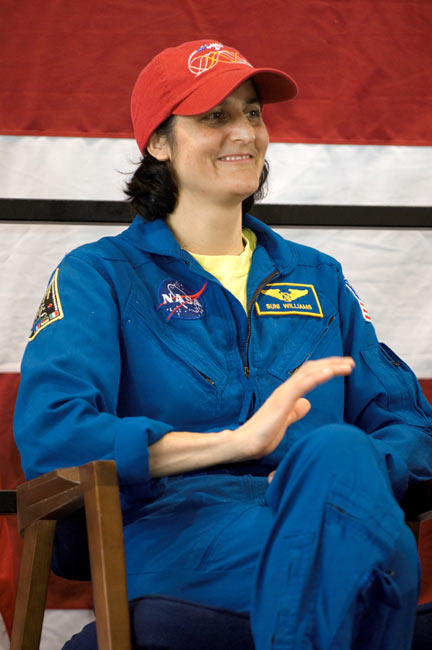NASA Astronaut Readapts to Life on Earth

NASAastronaut Sunita Williams is readapting to life on Earth after a record-settingmission to the International Space Station (ISS) that raised the bar for femalespaceflyers.
Williams, 41,spent nearly 195 days - a worldrecord for female astronauts - in space and served on two ISS crews duringher mission to the orbital laboratory. She returnedto Earth on June 22 alongside NASA's STS-117 astronaut crew aboard shuttleAtlantis after its successful construction flight to the ISS.
"Ithink I'm fit as a fiddle," Williams told reporters of her readaptation togravity's pull during a recent series of NASA TV interviews, adding that herarms and legs did feel a bit heavy at first. "The first 24 hours to 48 hourswas a little tough coming back and feeling the weight of gravity."
Williamssaid she spent her first week back on Earth exercising to rebuild the muscle massshe lost during the more than six months of weightlessness. She was also eagerto spend time with her family, husband Michael and beloved Jack Russell terrierGorby, whom the astronaut mentioned often during her spaceflight.
"I hada great reunion with them," Williams said of her return home to Houston onJune 23. "That night we had a big pizza, which is something that I waslooking forward to."
A native ofNeedham, Massachusetts and a commander in the U.S. Navy, Williams first launchedinto space in December 2006 as part of the shuttle Discovery'sSTS-116 astronaut crew. But unlike her shuttle crewmates, Williams stayed behindto join its then-Expedition 14 crew. She stayed aboard the station again inApril, as the orbital laboratory changed over to its Expedition 15 crew, beforereturning to Earth last month.
"It'sa blast, it?s so much fun and I'm going to miss it," Williams said lifeaboard the ISS, where weightlessness felt like combination of flying andswimming. "It's a completely different human experience."
Get the Space.com Newsletter
Breaking space news, the latest updates on rocket launches, skywatching events and more!
At justover six months in length, Williams' flight set a new endurance record as thelongest duration spaceflight by a female astronaut, though she has repeatedlysaid she was just in the right place at the right time.
Theprevious record of just over 188 days was held by fellow NASA astronaut ShannonLucid, who set that benchmark during a 1996 mission to Russia's Space StationMir. ?NASA astronaut Michael Lopez-Alegria, Williams' Expedition 14 commander,holds the overall U.S. title for longest spaceflight with 215 days, though theworld record of 438 days rests firmly in the hands of Russian cosmonaut Valery Polyakovafter his 1994-1995 flight.
Williamsalso ranthe Boston marathon from space and performed four spacewalks dedicated tooverhauling the station's power and cooling systems during her mission. With 29hours and 17 minutes of spacewalking time, she also holds the title of mostexperienced female spacewalker.
"Withouta doubt, the spacewalks were just incredible," Williams said. "When you'reoutside and you're in your own spacecraft, your spacesuit, and the only thingbetween you and space is your visor. That is pretty spectacular and you canlook out into the universe, then back at our planet."
Near theend of the spaceflight, while Atlantis and its STS-117 crew were docked at theISS, Williams also helped her Expedition 15 crewmates Fyodor Yurchikhin andOleg Kotov work through a majorcomputer systems glitch in the station's Russian segment. The successfulrepair, she said during the mission, is proof that space is a challenging andhostile environment for human exploration.
"Wetake spaceflight for granted and it's still pretty darned dangerous,"Williams told reporters during the joint mission, adding that the station is aship of science and not merely a space tourist destination. "It's a seriousplace and we're doing serious business and serious science up here."
WhileAtlantis' successful landing ended the first career spaceflight for Williams,she hopes it won't be her last. But, she said, there are many other astronautsstill in line for NASA's remaining shuttle flights to complete the ISS beforethe orbiter fleet is retired in 2010.
"It'sjust such a wonderful place to live and work," Williams said of the ISS afterthe spaceflight. "I really do hope to either go back to the space stationor?who knows, the Crew Exploration Vehicle hopefully will be going back to theMoon before long."
- VIDEO: Meet the Crew of Expedition 15
- SPACE.com Video Interplayer: Space Station Power Up with STS-117
- Complete Shuttle Mission Coverage
Join our Space Forums to keep talking space on the latest missions, night sky and more! And if you have a news tip, correction or comment, let us know at: community@space.com.

Tariq is the Editor-in-Chief of Space.com and joined the team in 2001, first as an intern and staff writer, and later as an editor. He covers human spaceflight, exploration and space science, as well as skywatching and entertainment. He became Space.com's Managing Editor in 2009 and Editor-in-Chief in 2019. Before joining Space.com, Tariq was a staff reporter for The Los Angeles Times covering education and city beats in La Habra, Fullerton and Huntington Beach. In October 2022, Tariq received the Harry Kolcum Award for excellence in space reporting from the National Space Club Florida Committee. He is also an Eagle Scout (yes, he has the Space Exploration merit badge) and went to Space Camp four times as a kid and a fifth time as an adult. He has journalism degrees from the University of Southern California and New York University. You can find Tariq at Space.com and as the co-host to the This Week In Space podcast with space historian Rod Pyle on the TWiT network. To see his latest project, you can follow Tariq on Twitter @tariqjmalik.









